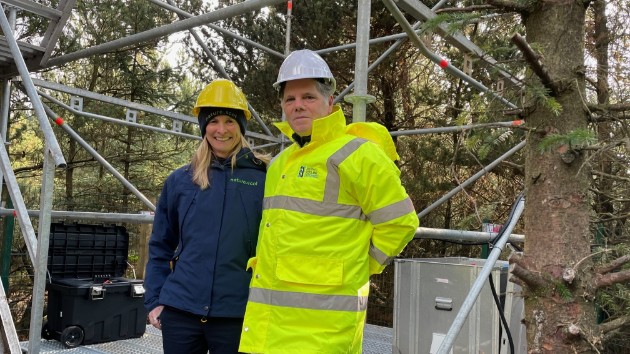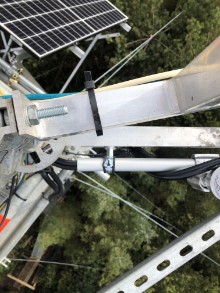14 March, 2024
First-ever flux tower installed in the South of Scotland to measure greenhouse gases

The South of Scotland is joining a national network of flux towers, with a unique project allowing greenhouse gases to be measured as the land changes from commercial forestry crops to restored peatland.
The 14-metre flux tower is the first-ever installed in the South of Scotland and sits within a commercial forestry crop planted upon deep peat soil 24 years ago. Critically, the tower will be the first to measure carbon dioxide and methane from the site as the trees grow, reach maturity and are felled, to see how emissions change as the land is restored back to open peatland.
Greenhouse gases have increased in our atmosphere due to human activity since the industrial revolution, causing the climate crisis. Understanding how Scotland’s land stores or releases these gases is key to reducing carbon emissions.
Peatlands are recognised as vital carbon stores and are the largest terrestrial store of carbon in the UK. Information from the flux tower, funded by NatureScot Peatland ACTION, will help fill critical gaps in the understanding of greenhouse gas emissions from peatlands in different conditions.
Globally, it will put Scotland at the forefront of understanding peatland restoration including how forests impact deep peat. It will also provide critical information for the Scottish Government towards its ambition to reach net zero emissions by 2045.
Data from the flux tower’s instrumentation will also be joined up with a national network of flux towers in Scotland (SCO2FLUX) and shared openly with key stakeholders in peatland restoration and forestry management.
This new flux tower is a collaboration between NatureScot Peatland ACTION, the UK Centre for Ecology & Hydrology, the Crichton Carbon Centre, Forestry and Land Scotland (FLS) and The James Hutton Institute.
Chris Boyce, from NatureScot’s Peatland ACTION Data & Evidence Team, said: “We are delighted to be funding such an important and ground-breaking addition to Scotland’s flux tower network. The data will help inform the Peatland ACTION Programme on the effectiveness of peatland restoration measures and how to best manage existing peatland carbon stores in the future. Installing the tower is a major milestone and follows years of close collaboration across organisations. It’s fantastic to be moving into the next phase of the project and starting to generate results.”
Dr Emily Taylor, General Manager for the Crichton Carbon Centre, the lead partner of the project, said: “It's a really exciting project and the first of its kind in the South of Scotland. To be part of an international network of similar monitoring stations will hugely benefit our understanding of emissions from peatlands under forestry and then subsequently restored and is a step forward in evidencing how we can reach our net zero ambitions.
“This project has been many years in the making and we’re committed to taking on the management of the project and developing this exciting research partnership. We hope this tower and research partnership will provide further opportunities for researchers and projects in the South of Scotland.”
Ed Turner, FLS Planning Manager, said: “The site is part of an extensive lowland raised bog. The trees on this site were planted a quarter of a century ago when the understanding of trees impact on peatland sites was not as developed as it is today. The location of the flux tower is significant in that it will allow greenhouse gas emissions to be measured above the canopy of a maturing second rotation Sitka spruce and lodgepole pine conifer plantation on deep peat.
“This new flux tower will help to further develop our understanding of this extremely complex area and help refine the approach to managing land to best effect. Once the trees on this site are felled for timber next decade, there will be no further replanting and the area will be restored to open peatland habitat.”
Dr Carole Helfter, environmental physicist from UKCEH, which has led the installation and set up of the flux monitoring equipment, explained: “If we are to meet net zero targets, we need to be able to quantify the land’s capacity to sequester carbon and to understand the control mechanisms of greenhouse gas emissions. Adding this project to the flux tower network – designed to help us understand the fundamental drivers for climate change – will give us added clues to that complex puzzle.”
Dr Mhairi Coyle, greenhouse gas and carbon dynamics researcher from The James Hutton Institute, which are leading on the retrieval and analysis of the flux equipment data, added: “What makes this project so exciting is that, while the equipment will measure carbon dioxide exchange as well as the usual meteorological data, it is also the first tower on forested deep peat measuring landscape-scale methane exchange. Methane is a potent greenhouse gas, and this research will provide additional insights into land management practices that minimise its emission.”
The tower was erected by Dulas, an award-winning renewable energy installer and consultancy. Locally, the project has been supported by Craig Williamson with fencing installation and Clark Scaffolding who will also help monitor the structure.
This project has also benefited from funding from South of Scotland Enterprise.
Updates on the project will be shared on the Crichton Carbon Centre website.
ENDS
Contact information
- Name
- NatureScot Media
- Telephone
- 0131 316 2655
- media@nature.scot
Notes to editors
Flux towers are micro-meteorological tower sites that use eddy covariance methods to measure and calculate vertical turbulence fluxes (the upward and downward movement) of trace-gas concentrations by an ecosystem and how it changes over time. The standard method employs fast-response instruments to measure trace-gas concentrations and wind speed/direction which estimate the net exchange of carbon dioxide CO2. Readings are captured though sensors fitted to the tower. The data helps quantify the amount of carbon stored in different ecosystems (vegetation), site-to-site variation, and how it may be modified in land use, land management or climate change. Other meteorological measurements are also usually recorded such as wind speed and direction.
SCO2FLUX Peatland research network: The main focus of the SCO2FLUX or GHG monitoring network is on Scottish peatlands because of their key potential role in mitigating climate change, maintaining biodiversity and managing water resources when in good ecological condition. The site network is designed to fill important evidence gaps in our understanding of Scottish land use impacts on emissions and forms an important part of the UK-wide network of sites that contribute to the continued development and revision of the peatland Tier 2 emission factors in the UK GHG Inventory. They also feed directly into the training and validation of models and efforts to understand future feedbacks on global climate.
The Crichton Carbon Centre - The Crichton Carbon Centre is an independent, environmental not-for-profit organisation established in 2007. CCC specialises in peatland restoration, carbon management, sustainable land-use and environmental education. CCC exchanges their specialist knowledge and practical experiences with nurtured partnerships and communities to catalyse change and bring climate resilience.
Forestry and Land Scotland - Forestry and Land Scotland (FLS) manages forests and land owned by Scottish Ministers in a way that supports and enables economically sustainable forestry; conserves and enhances the environment; delivers benefits for people and nature; and supports Scottish Ministers in their stewardship of Scotland's national forests and land.
The James Hutton Institute - The James Hutton Institute is at the forefront of meeting the global challenges of providing food, energy and water from finite land and natural resources. The institute’s strengths in land, crop, waters, environmental and socio-economic sciences enable a broad range of science disciplines to interconnect, delivering knowledge, products and services that improve the quality of life. In partnership with people, organisations and governments, the institute’s work enhances sustainable environmental, social and economic development, delivering practical solutions for our shared future and influencing the agenda for land use and development for the 21st Century.
The UK Centre of Ecology and Hydrology - The UK Centre for Ecology & Hydrology is an independent, not-for-profit research institute carrying out excellent environmental science with impact. Our 500+ scientists work to understand the environment, how it sustains life, and the human impact on it. We provide the data and insights that governments, businesses and researchers need to create a productive, resilient and healthy environment. Scientific curiosity, integrity and transparency are at the heart of how we work. www.ceh.ac.uk
NatureScot’s PeatlandACTION - Peatland ACTION is a Scottish Government funded initiative focused on the restoration of damaged peatlands in Scotland for the many benefits to both people and nature. Funding comes through the Scottish Government’s Climate Change Plan to net zero to restore 250,000 hectares by 2030. The Peatland ACTION programme is delivered through a network of partner organisations* including NatureScot - Scotland’s nature agency.
South of Scotland Enterprise - South of Scotland Enterprise is the development agency for businesses and communities throughout Dumfries & Galloway and the Scottish Borders. SOSE is here to help people and enterprises in the South to thrive, grow, and fulfil their best potential. Every enterprise is different, and SOSE support is tailored every stage and situation.
Dulas - With over 40 years of experience in the clean energy sector, Dulas is an award-winning renewable energy installer and consultancy, specialising in the wind, solar and hydro sectors. Since 1982 Dulas has been at the forefront of renewables innovation, helping to plan and install some of the very first UK wind farms. To date, the firm’s engineers, planners and consultants have worked on over 400 MW of renewables projects across the UK, offering a complete package of development services to utility, commercial, community and landowner renewable energy schemes.
NatureScot is Scotland's nature agency. We work to enhance our natural environment in Scotland and inspire everyone to care more about it. Our priority is a nature-rich future for Scotland and an effective response to the climate emergency. For more information, visit our website at www.nature.scot or follow us on X at https://x.com/NatureScot
’S e NatureScot buidheann nàdair na h-Alba. Bidh sinn a’ neartachadh àrainneachd na h-Alba agus a’ brosnachadh dhaoine gu barrachd suim a chur ann an nàdar. Tha e mar phrìomhachas againn gum bi nàdar na h-Alba beairteach agus gun dèilig sinn gu h-èifeachdach le èiginn na gnàth-shìde. Tha an tuilleadh fiosrachaidh aig www.nature.scot no air X aig https://x.com/NatureScot
Downloads

NatureScot Chief Executive Francesca Osowska and South of Scotland's Director of Net Zero, Nature & Entrepreneurship, Dr Martin Valenti, at the Flux Tower - free use picture - please credit NatureScot

View from top of flux tower of tree canopy -Free use - please credit Chris Boyce-NatureScot Peatland ACTION

Dr Emily Taylor, General Manager for the Crichton Carbon Centre at the top of the flux tower - free use - please credit Crichton Carbon Centre


